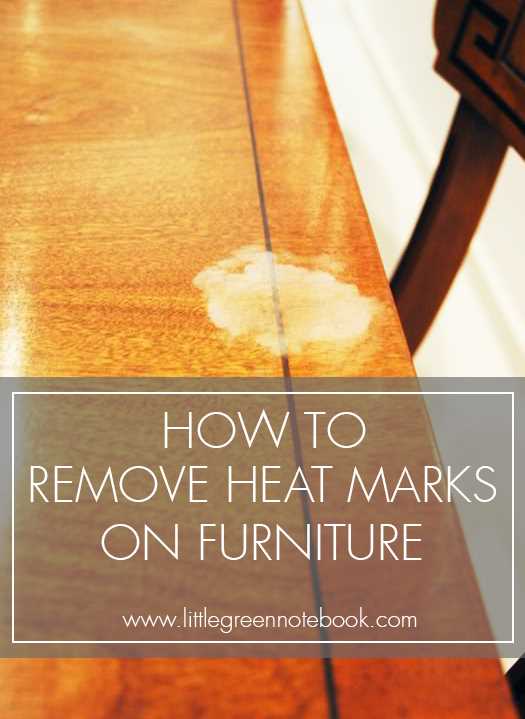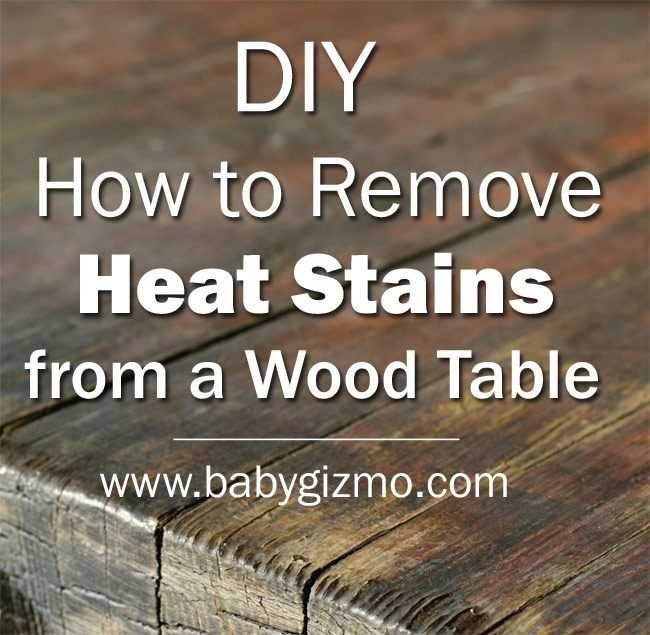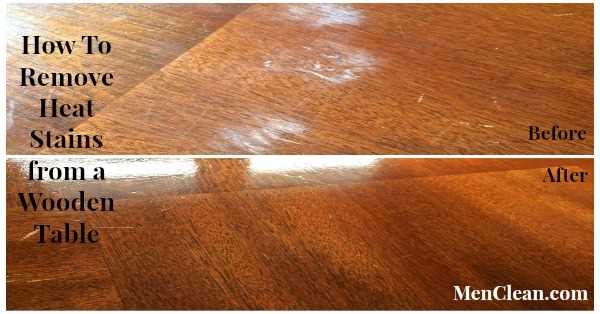




Wooden furniture and surfaces can easily get heat marks from hot dishes, cups, or pans. These unsightly marks can be frustrating to deal with and may seem impossible to remove. However, there are several effective ways to remove heat marks from wood and bring back its original beauty.
1. Use an iron and a towel: One of the most common methods to remove heat marks is by using an iron and a towel. Place a clean towel directly over the heat mark and set the iron to a low-medium heat setting. Gently iron over the towel, moving the iron in circular motions for about 30 seconds. The heat from the iron should help lift the moisture from the wood and remove the mark.
2. Apply toothpaste: Another simple trick is to use toothpaste. Apply a small amount of non-gel toothpaste directly onto the heat mark and gently rub it in circular motions with a soft cloth. Allow the toothpaste to sit for a few minutes, then wipe it off with a clean, damp cloth. Repeat the process if necessary until the mark fades.
3. Try mayonnaise: Yes, you read it right. Mayonnaise can also be used to remove heat marks from wood. Apply a thin layer of regular mayonnaise onto the heat mark and let it sit for a few hours. The oil in the mayonnaise helps penetrate the wood and lift the mark. After a few hours, wipe off the mayonnaise with a clean cloth and assess the results. Repeat if needed.
4. Sand and refinish: If the heat mark is stubborn and none of the previous methods work, you may consider sanding and refinishing the affected area. This method requires a little more effort, but it can effectively remove deep heat marks. Begin by sanding the area gently with fine-grit sandpaper until the mark is no longer visible. Then, apply a wood finish that matches your furniture or surface, following the manufacturer’s instructions.
Remember, prevention is always better than cure. To avoid heat marks on your wooden furniture, use coasters, trivets, or heat-resistant mats to protect the surface from hot objects. Taking small preventive measures can go a long way in maintaining the beauty of your wood and avoiding the hassle of removing heat marks.
Natural Methods
Lemon Juice and Olive Oil
Mix lemon juice and olive oil in equal parts and apply it to the heat mark using a soft cloth. Gently rub the mixture over the mark in circular motions for a few minutes.
Note: This method works best for lighter heat marks on wood surfaces.
Vinegar and Olive Oil
Create a mixture by combining equal parts of vinegar and olive oil. Use a cloth to apply the mixture to the heat mark and gently rub it in circular motions for a few minutes.
Note: Vinegar may have a strong smell, so make sure to work in a well-ventilated area.
Baking Soda and Toothpaste
Make a thick paste by mixing baking soda and toothpaste. Apply the paste to the heat mark and gently rub it in circular motions using a soft cloth.
Note: This method is effective for removing heat marks that have penetrated the top layer of the wood.
Mayonnaise
Apply a small amount of mayonnaise to the heat mark and gently rub it in circular motions using a soft cloth. Let it sit for a few hours or overnight before wiping it away.
Note: Allow the mayonnaise to fully penetrate the wood to effectively remove the heat mark.
Steel Wool and Lemon Juice
Combine steel wool and lemon juice to create a paste. Apply the paste to the heat mark and gently rub it in circular motions using the steel wool. Wipe away any residue with a clean cloth.
Note: This method should be used cautiously, as steel wool can scratch the wood surface.
| Natural Method | Materials Needed |
|---|---|
| Lemon Juice and Olive Oil | Lemon juice, Olive oil, Soft cloth |
| Vinegar and Olive Oil | Vinegar, Olive oil, Soft cloth |
| Baking Soda and Toothpaste | Baking soda, Toothpaste, Soft cloth |
| Mayonnaise | Mayonnaise, Soft cloth |
| Steel Wool and Lemon Juice | Steel wool, Lemon juice, Soft cloth |
Tip: It’s always a good idea to test any of these natural methods on a small, inconspicuous area of the wood before using them on the heat mark to avoid any potential damage to the surface.
Using Household Items
If you don’t have any specialized products for removing heat marks from wood, you’re in luck! There are several household items that can be used to effectively remove these unsightly marks.
1. Vinegar and Olive Oil
Mix equal parts vinegar and olive oil in a small bowl or container. Dampen a clean cloth with the mixture and gently rub it onto the heat mark in a circular motion. Continue rubbing until the mark starts to fade. Once the mark is gone, wipe away any excess residue with a fresh cloth.
2. Baking Soda and Toothpaste
Create a paste using baking soda and a small amount of toothpaste. Apply the paste to the heat mark and gently rub it into the wood using a clean cloth. Keep rubbing until the mark fades. Once the mark is gone, wipe away any remaining residue with a fresh cloth dampened with water.
3. Mayonnaise

Apply a generous amount of mayonnaise directly to the heat mark. Allow it to sit for several hours or overnight. The oils in the mayonnaise will help to moisturize the wood and lift the heat mark. After the designated time has passed, wipe away the mayonnaise with a clean cloth. If the mark is still visible, repeat the process.
4. Hairdryer and Iron
- Place a clean cloth over the heat mark.
- Set your hairdryer to low heat and hold it a few inches away from the cloth.
- Moving the hairdryer in a circular motion, heat the cloth for a few minutes. This will help to loosen and lift the heat mark.
- Remove the cloth and check if the mark has faded. If it’s still visible, continue to the next step.
- Place another clean cloth over the heat mark.
- Set your iron to a low heat setting, and gently glide it over the cloth, applying slight pressure. Make sure not to leave the iron in one spot for too long, as it can potentially damage the wood.
- Check the mark after a few passes with the iron. If it’s still visible, repeat the process until the mark is gone.
5. Table Salt and Vegetable Oil
Mix equal parts table salt and vegetable oil in a small bowl to create a paste. Apply the paste to the heat mark and gently rub it into the wood using a clean cloth. Continue rubbing until the mark starts to fade. Once the mark is gone, wipe away any remaining residue with a fresh cloth.
These household items can be effective in removing heat marks from wood surfaces. However, always test these methods on a small, inconspicuous area of the wood first to ensure they do not cause any damage or discoloration.
Commercial Products
If homemade remedies do not remove the heat marks from your wood furniture, you may want to consider using commercial products specially designed for this purpose. These products are widely available in hardware stores, online retailers, and furniture stores. Here are some popular options:
Heat Mark Remover
Heat mark remover is a product specifically formulated to remove white or cloudy heat marks from wood surfaces. It typically comes in the form of a cream or a liquid. To use it, you simply apply the product to the affected area, let it sit for a few minutes, and then wipe it off with a clean cloth. Make sure to follow the instructions provided by the manufacturer.
Wood Reviver
Wood reviver is another product that can help remove heat marks from wood. It is designed to restore the natural color and shine of the wood. To use it, you apply a small amount of the product to a clean cloth and gently rub it onto the heat mark in circular motions. Continue rubbing until the mark is no longer visible, then wipe away any residue with a clean cloth.
Citrus or Oil-based Furniture Polishes
Citrus or oil-based furniture polishes can also be effective in removing heat marks from wood surfaces. These products contain ingredients that help dissolve and lift the heat marks. To use them, apply a generous amount of the polish to the affected area and let it sit for a few minutes. Then, gently rub the area with a clean cloth in circular motions. Once the mark is gone, wipe away any residue with a clean cloth.
Caution
Before using any commercial product on your wood furniture, be sure to read and follow the instructions provided by the manufacturer. Test the product on a small, inconspicuous area first to ensure it does not cause any damage or discoloration to your furniture. If you are unsure about using commercial products, it may be best to consult a professional furniture restorer.
Sanding and Refinishing
If the heat mark on your wood surface is stubborn and cannot be removed using simple home remedies, you may need to resort to sanding and refinishing techniques. This method involves using sandpaper or a power sander to remove the top layer of the wood and then refinishing it with paint, stain, or varnish to restore its original appearance.
Materials Needed:
- Sandpaper (or power sander)
- Protective goggles and mask
- Wood filler (if necessary)
- Primer
- Paint, stain, or varnish
- Paintbrush or foam applicator
- Lint-free cloth
Step 1: Prepare the Work Area
Start by preparing the work area to avoid any mess or damage to surrounding objects. Lay down a drop cloth or old newspapers to catch any dust or debris that may be created during the sanding process.
Step 2: Sand the Heat Mark

Using sandpaper or a power sander, gently sand the heat mark in the direction of the wood grain. Start with a coarse-grit sandpaper and gradually move to finer-grit sandpapers until the mark is no longer visible. Be careful not to exert too much pressure or sand too aggressively, as this could damage the wood further.
Step 3: Fill in any Indentations

If the heat mark has left behind any indentations or grooves, you may need to use wood filler to fill them in. Follow the manufacturer’s instructions for the wood filler and allow it to dry completely before proceeding.
Step 4: Prime the Surface

Before applying paint, stain, or varnish, it’s important to prime the sanded area to ensure proper adhesion and a smooth finish. Use a primer that is suitable for your chosen finishing product and apply it evenly with a paintbrush or foam applicator.
Step 5: Apply the Finishing Product
Once the primer is dry, you can proceed to apply your chosen finishing product, whether it’s paint, stain, or varnish. Follow the manufacturer’s instructions for application and allow the first coat to dry completely before applying additional coats, if necessary.
Step 6: Buff and Polish
After the final coat of finishing product has dried, you can use a lint-free cloth to buff and polish the surface, giving it a smooth and glossy appearance. This step will help blend the refinished area with the surrounding wood and make the heat mark less visible.
Step 7: Maintenance
To keep your refinished wood surface looking its best, regularly clean and dust it with a soft cloth or microfiber duster. Avoid placing hot items directly on the surface and use coasters or trivets to protect it from heat marks in the future.
Sanding and refinishing is a more intensive and time-consuming method for removing heat marks from wood, but it can be highly effective in restoring the appearance of damaged surfaces. If you’re unsure about performing these steps yourself, it’s always best to consult a professional to avoid causing further damage to the wood.
Preventive Measures
1. Use Coasters or Trivets
One of the easiest ways to prevent heat marks on wood surfaces is to use coasters or trivets for hot items. Place a coaster or trivet under hot mugs, pans, or plates to protect the wood from direct contact with heat.
2. Use Pot Holders or Oven Mitts

When placing hot pots or pans on wooden surfaces, always use pot holders or oven mitts to create a barrier between the hot object and the wood. This helps prevent heat damage and potential heat marks.
3. Place Hot Items on Heat-Resistant Mats
For larger hot items, such as casserole dishes or baking trays, place a heat-resistant mat or trivet under them before placing them on the wood surface. This will provide additional protection against heat transfer and potential heat marks.
4. Avoid Placing Hot Items Directly on Wood
As a general rule, avoid placing hot items directly on wood surfaces whenever possible. Instead, opt for using heat-resistant materials or surfaces, such as granite or marble countertops, for hot objects to minimize the risk of heat marks on wood.
5. Use Tablecloths or Placemats
Consider using tablecloths or placemats on dining tables or other wooden surfaces to provide an extra layer of protection. These can help absorb and disperse heat, reducing the likelihood of heat marks appearing on the wood.
6. Keep the Surface Clean and Dry
Moisture can intensify the effects of heat on wood, making it easier for heat marks to occur. Ensure the wood surface is clean and dry before placing any hot items on it, as this can help minimize the chances of heat marks appearing.
By following these preventive measures, you can significantly reduce the risk of heat marks on your wooden furniture or surfaces. Taking these simple steps will help preserve the beauty and quality of your wood for years to come.
FAQ
What are heat marks on wood?
Heat marks on wood are the white or light-colored stains that appear on the surface of wooden furniture when a hot object is placed on it without any protective barrier. They are caused by the heat and moisture trapped between the object and the wood, which then reacts with the finish and creates the mark.
What are some effective ways to remove heat marks from wood?
There are several effective ways to remove heat marks from wood. One method is to use an iron and a cloth. Place the cloth over the heat mark and apply heat from the iron for a few seconds, moving it constantly. This will help lift the moisture and restore the wood’s surface. Another method is to use mayonnaise or toothpaste. Apply a small amount of either onto the heat mark, let it sit for a few hours or overnight, then wipe it off with a clean cloth. Sanding the heat mark is also an option, but should be done carefully to avoid further damage to the wood.
Can vinegar be used to remove heat marks from wood?
No, vinegar is not recommended for removing heat marks from wood. Vinegar is acidic and can potentially strip off the finish or damage the wood’s surface. It is best to use other methods such as using an iron and cloth, mayonnaise, or toothpaste to remove heat marks from wood.
Can heat marks be prevented on wooden furniture?
Yes, heat marks can be prevented on wooden furniture. It is important to always use protective barriers such as coasters, trivets, or hot pads when placing hot objects on wooden surfaces. These barriers will help prevent heat and moisture from being trapped between the object and the wood, reducing the likelihood of heat marks.
Is refinishing necessary after removing heat marks from wood?
Refinishing is not always necessary after removing heat marks from wood. In some cases, the heat mark can be effectively and completely removed using methods such as an iron and cloth, mayonnaise, or toothpaste. However, if the heat mark is deep or has caused severe damage to the wood’s surface, refinishing may be necessary to restore the appearance of the furniture.
Are there any professional services available for removing heat marks from wood?
Yes, there are professional services available for removing heat marks from wood. Furniture restoration experts and woodworkers often offer services to repair and restore wooden furniture, including removing heat marks. If the heat mark is extensive or if you are unsure about how to remove it yourself, it may be worth consulting a professional to ensure the best results.













